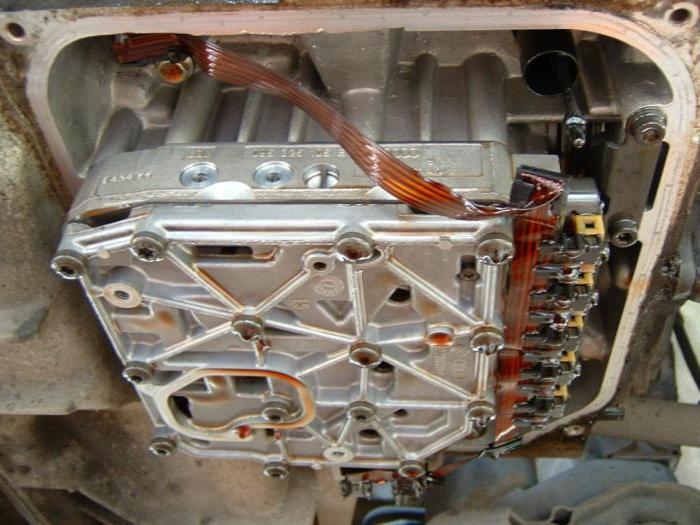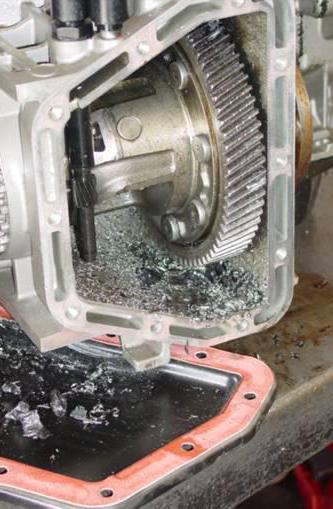Automatic transmissions do not run on traditional gear oils. They are filled with special ATF oil. This fluid is a high index mineral or synthetic base composition. Such fluids for automatic transmissions allow for the operation of systems that control and control gear changes. Also, through this fluid, torque is transmitted from the engine to the automatic transmission. Additionally, ATF oil lubricates friction parts and cools them.
How ATF fluids were created
The first automatic transmission was created in 1938. This design is called Hydramatic. It was distinguished by a vacuum gear shift system. This unit was created by Pontiac engineers. Even then, the company was part of the General Motors automobile concern.
Since
General Motors, before launching any innovative development, preferred to pre-test it and test it in every way, the new automatic transmission was installed on Oldsmobile. The tests were successful. And already in the year 39, Hydromatic was installed as an option on the Oldsmobile Custom 8 Cruiser. Such an option cost 57 dollars.
The role of General Motors in creating the first ATF
By the end of the 40s, automatic transmission managed to become a familiar part of cars. And it is not surprising that the first ATF oil for automatic transmission was created specifically by General Motors specialists. It was the world's first transmission fluid specification. It was called Type A. The fluid was created in 1949. Then GM began to develop transmission oils, and later to classify and put forward the most stringent requirements for them. Products that were created in the laboratories of General Motots, due to the lack of competition, have become the international standard for working fluids for any type of automatic transmission.
From Whale Fat to New Technology
In 1957, the already existing specification was revised and decided to add one small new application - Type A Suffix A transmission fluid (short for ATF-TASA). After 10 years, specification B was created (this is ATF Dexron-B).
As the main ingredient, due to which the liquid had lubricating properties, blubber was used - this is the fat that was obtained from whales. But then the development of technology in the production of automatic boxes forced the concern to introduce something new. So, in 1973, a new Dexron 2C specification was developed. In 1981, it will be replaced by Dexron-2D. After a flurry of negativity from animal defenders hit the corporation, and also after a ban on whale fishing, the company in 1991 created the innovative Dexron-2E formula. The difference of this product is that it is created on a synthetic basis. Previously, lubrication was carried out on a mineral basis.
Birth of Dexron-4
In 1994, the entire world community learned about new specifications, which set out new requirements for viscosity properties and temperature characteristics. Also, the specification implied more improved frictional properties. These are Dextron-3F and Dextron-3G. After 8 years, Dextron-3H is released. But the most modern and the most rigid is ATF Dexron-4. Of course, today there are other specifications from other automotive manufacturers. These are such giants as Ford, Toyota, Huinday and others.
How is ATF different from other gear oils?
To understand the difference, you need to approach the issue from afar. Automobiles use engine oils, gearboxes, hydraulic amplifiers and ATF oil. What are the similarities between all these fluids? These oils are based on hydrocarbons, which are obtained through the processing of minerals. This gives some similarities in characteristics. All of these tools have lubricating properties, increase the slip between the rubbing surfaces.
All of these fluids also have good heat dissipation characteristics. They are similar in consistency. This is where all the similarities end. This is sometimes the cause of gross errors when a novice motorist pours oil for the "mechanics" into the automatic transmission, and brake fluid in the power steering.
Key ATF Features
ATF oil is one of the most complex fluids in terms of composition among all lubricant mixtures used in a modern car. Such grease is subject to high requirements and standards. The oil should have a lubricating effect - due to this, friction is reduced, and at the same time, wear in the gearbox elements is reduced. In this case, the friction forces in friction groups should increase. This will reduce slippage of brake bands and other components.

Another important property is heat dissipation. The oil has high thermal conductivity and flow characteristics. In this case, the liquid should not foam during operation. An important point is stability, namely the absence of oxidative processes when heated to high temperatures at the moment of contact with oxygen. Additionally, the oil must have anti-corrosion properties. This is necessary in order to prevent the formation of corrosion on the internal nodes of the mechanism. The automatic transmission fluid must be hydrophobic (this is the ability to push moisture from the surface). In this case, it is necessary that the fluid retains its flow characteristics and hydraulic characteristics. ATF grease has stable characteristics and a high degree of compression over the widest temperature range. Another point is the reduction in penetration through automatic transmission and the presence of dye.
Typical Automatic Gear Lubricants
Consider a few ATF oil specifications, specifications, and numbers. For the Dexron-2 specification, the kinematic viscosity is 37.7 at 40 C. At 100 degrees, the same parameter will be 8.1. For Dexron-3, the kinematic viscosity is not standardized at all, as well as for other specifications.
The Brooksfield ATF viscosity for Dexron-2 at a temperature of 20 degrees should be 2000 MPa, at 30 - 6000 MPa, at 40 - 50 000 MPa. The same parameter for Dexron-3 will be 10 if the pressure is 1500 MPa. Flash point - no lower than 190 degrees for Dexron-2. For Dexron-3 - this parameter is 179 degrees, but not higher than 185.
ATF Oil Compatibility
Any oil (whether it is mineral or synthetic) can be mixed without any consequences. Naturally, more modern fluids have improved characteristics and properties. If modern liquid is added to ordinary, then this will improve the properties of the filled oil. The older the specification, the lower performance it will have. Also, the shelf life of ATF is an order of magnitude lower. Experts recommend changing this fluid every 70 thousand kilometers. It is worth noting that many modern manufacturers do not regulate the period of replacement of this fluid. It is poured for the entire service life. But when a car takes care of 200 thousand kilometers in one oil, this is not very good. The fact is that the fluid in the automatic transmission is working. It is she who transfers the torque from the engine to the wheels. This oil is constantly in operation, even when the machine is at neutral speed. Over time, it collects production products.

This is metal shavings that clogs the filter and sensors. As a result, the box ceases to function normally. Now to the issue of compatibility. No brand will ever fully disclose all information regarding the composition and properties of the produced fluid. Often manufacturers are limited only to marketing information and advertising, forcing them to buy only a specific product. But often this information is groundless. For transmissions with hard engagement of torque converter locks, it is recommended to use fluids with constant frictional characteristics.
For automatic transmissions with GTF locking, products with variable properties should be poured. And finally, regardless of the automatic transmission model, all parts, bearings, gears and other elements are made of the same materials. This means that the various types of ATF are not particularly different from each other.
About application and compatibility features
If the oil in the box changes entirely, then it is best to purchase a more expensive product. In this case, constant or variable frictional characteristics must be taken into account. If the budget is limited, then even ATF universal oil is suitable. Its application will not affect the quality of the box. If the liquid is topped up, then experts recommend using products with a class above or at least not lower than the filled one. But if its resource has reached 70 thousand kilometers, a complete replacement is necessary. Additional flushing is advisable. This operation takes up to an additional 20 liters of oil. It is not cheap, but judging by the reviews, this operation perfectly washes chips. And its presence, as you know, complicates the work of an automatic transmission.
So, we found out what ATF oil is for automatic transmission.